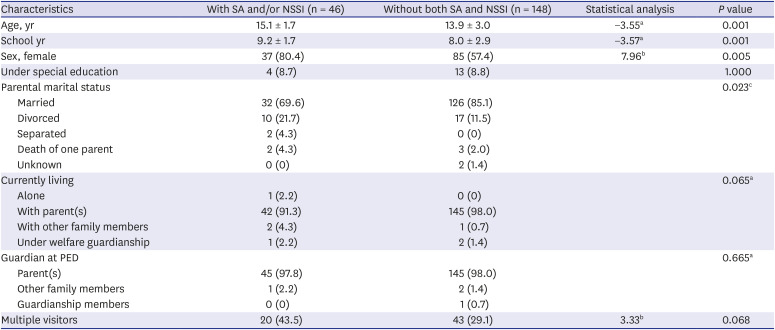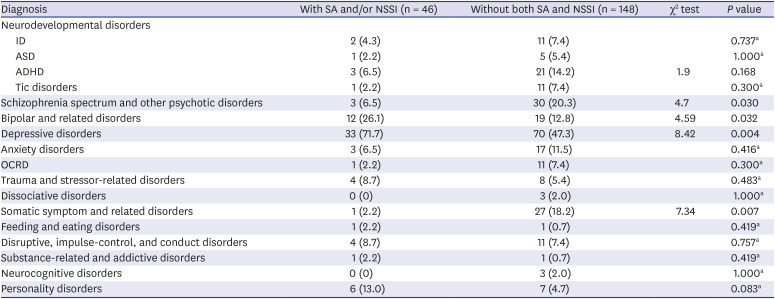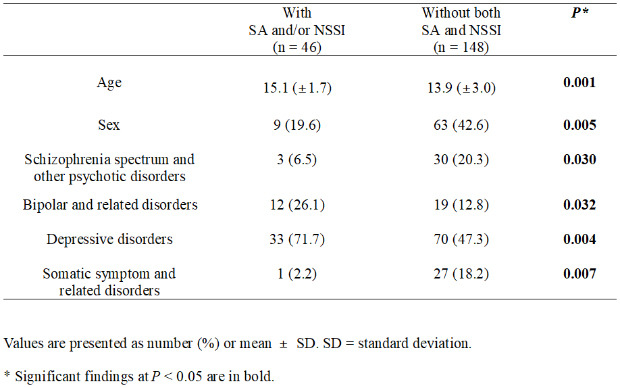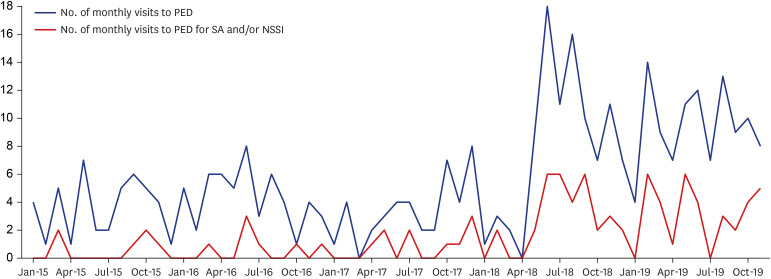1. Nock MK. Self-injury. Annu Rev Clin Psychol. 2010; 6(1):339–363. PMID:
20192787.

2. Muehlenkamp JJ, Claes L, Havertape L, Plener PL. International prevalence of adolescent non-suicidal self-injury and deliberate self-harm. Child Adolesc Psychiatry Ment Health. 2012; 6(1):10. PMID:
22462815.

6. American Psychiatric Association. Diagnostic and Statistical Manual of Mental Disorders (DSM-5®). Philadelphia, PA: American Psychiatric Association;2013.
7. Lim M, Lee S, Park JI. Differences between impulsive and non-impulsive suicide attempts among individuals treated in emergency rooms of South Korea. Psychiatry Investig. 2016; 13(4):389–396.

8. Plener PL, Allroggen M, Kapusta ND, Brähler E, Fegert JM, Groschwitz RC. The prevalence of nonsuicidal self-injury (NSSI) in a representative sample of the German population. BMC Psychiatry. 2016; 16(1):353. PMID:
27760537.

9. Giletta M, Scholte RH, Engels RC, Ciairano S, Prinstein MJ. Adolescent non-suicidal self-injury: a cross-national study of community samples from Italy, the Netherlands and the United States. Psychiatry Res. 2012; 197(1-2):66–72. PMID:
22436348.

10. Lee WK. Psychological characteristics of self-harming behavior in Korean adolescents. Asian J Psychiatr. 2016; 23:119–124. PMID:
27969068.

11. Kim M, Yu J. Factors contributing to non-suicidal self injury in Korean adolescents. J Korean Acad Nurs. 2017; 28(3):271–279.

12. Shin YM, Chung YK, Lim KY, Lee YM, Oh EY, Cho SM. Childhood predictors of deliberate self-harm behavior and suicide ideation in Korean adolescents: a prospective population-based follow-up study. J Korean Med Sci. 2009; 24(2):215–222. PMID:
19399261.

13. Shepard DS, Gurewich D, Lwin AK, Reed GA Jr, Silverman MM. Suicide and suicidal attempts in the United States: costs and policy implications. Suicide Life Threat Behav. 2016; 46(3):352–362. PMID:
26511788.

14. Jarvi S, Jackson B, Swenson L, Crawford H. The impact of social contagion on non-suicidal self-injury: a review of the literature. Arch Suicide Res. 2013; 17(1):1–19. PMID:
23387399.

15. Porter M, Gracia R, Oliva JC, Pàmias M, Garcia-Parés G, Cobo J. Mental health emergencies in paediatric services: characteristics, diagnostic stability and gender differences. Actas Esp Psiquiatr. 2016; 44(6):203–211. PMID:
27906411.
16. Cloutier P, Martin J, Kennedy A, Nixon MK, Muehlenkamp JJ. Characteristics and co-occurrence of adolescent non-suicidal self-injury and suicidal behaviours in pediatric emergency crisis services. J Youth Adolesc. 2010; 39(3):259–269. PMID:
19856090.

17. Cutler GJ, Flood A, Dreyfus J, Ortega HW, Kharbanda AB. Emergency department visits for self-inflicted injuries in adolescents. Pediatrics. 2015; 136(1):28–34. PMID:
26077475.

18. Kalb LG, Stapp EK, Ballard ED, Holingue C, Keefer A, Riley A. Trends in psychiatric emergency department visits among youth and young adults in the US. Pediatrics. 2019; 143(4):e20182192. PMID:
30886112.

19. Gill PJ, Saunders N, Gandhi S, Gonzalez A, Kurdyak P, Vigod S, et al. Emergency department as a first contact for mental health problems in children and youth. J Am Acad Child Adolesc Psychiatry. 2017; 56(6):475–482.e4. PMID:
28545752.

21. Grupp-Phelan J, Harman JS, Kelleher KJ. Trends in mental health and chronic condition visits by children presenting for care at U.S. emergency departments. Public Health Rep. 2007; 122(1):55–61.

22. Sills MR, Bland SD. Summary statistics for pediatric psychiatric visits to US emergency departments, 1993–1999. Pediatrics. 2002; 110(4):e40. PMID:
12359813.

23. Shah M, John AR, Dennis CG. Emergency department trends for pediatric and pediatric psychiatric visits. Pediatr Emerg Care. 2006; 22(9):685–686.

24. Otani T, Irioka T, Igarashi S, Kaneko K, Takahashi T, Yokota T. Self-remitting cerebral cortical encephalitis associated with myelin oligodendrocyte glycoprotein antibody mimicking acute viral encephalitis: a case report. Mult Scler Relat Disord. 2020; 41:102033. PMID:
32146429.

25. Brown AK, Damus K, Kim MH, King K, Harper R, Campbell D, et al. Factors relating to readmission of term and near-term neonates in the first two weeks of life. J Perinat Med. 1999; 27(4):263–275. PMID:
10560077.

26. Goldman-Mellor S, Olfson M, Lidon-Moyano C, Schoenbaum M. Association of suicide and other mortality with emergency department presentation. JAMA Netw Open. 2019; 2(12):e1917571. PMID:
31834399.

27. Goldstein AB, Frosch E, Davarya S, Leaf PJ. Factors associated with a six-month return to emergency services among child and adolescent psychiatric patients. Psychiatr Serv. 2007; 58(11):1489–1492. PMID:
17978263.

28. Chen YY, Yip PS, Chan CH, Fu KW, Chang SS, Lee WJ, et al. The impact of a celebrity's suicide on the introduction and establishment of a new method of suicide in South Korea. Arch Suicide Res. 2014; 18(2):221–226. PMID:
24620837.

29. Kim WJ, Song YJ, Namkoong K, Kim JM, Yoon HJ, Lee E. Does a copycat effect exist in the emergency department? Int J Psychiatry Med. 2013; 45(1):59–72. PMID:
23805604.

30. Xian L, Vickers SD, Giordano AL, Lee J, Kim IK, Ramaswamy L. # selfharm on Instagram: Quantitative Analysis and Classification of Non-Suicidal Self-Injury. In : 2019 IEEE First International Conference on Cognitive Machine Intelligence (CogMI); Piscataway, NJ: Institute of Electrical and Electronics Engineers;2019. p. 61–70.
31. Tseng FY, Yang HJ. Internet use and web communication networks, sources of social support, and forms of suicidal and nonsuicidal self-injury among adolescents: different patterns between genders. Suicide Life Threat Behav. 2015; 45(2):178–191. PMID:
25255896.

32. Scherr S, Arendt F, Frissen T, Oramas J. Detecting intentional self-harm on Instagram: development, testing, and validation of an automatic image-recognition algorithm to discover cutting-related posts. Soc Sci Comput Rev. Forthcoming. 2019; DOI:
10.1177/0894439319836389.

33. Gould MS, Shaffer D. The impact of suicide in television movies. Evidence of imitation. N Engl J Med. 1986; 315(11):690–694. PMID:
3748073.
34. Suh S, Chang Y, Kim N. Quantitative exponential modelling of copycat suicides: association with mass media effect in South Korea. Epidemiol Psychiatr Sci. 2015; 24(2):150–157. PMID:
24495411.

35. Kessler RC, Borges G, Walters EE. Prevalence of and risk factors for lifetime suicide attempts in the national comorbidity survey. Arch Gen Psychiatry. 1999; 56(7):617–626. PMID:
10401507.

36. Mościcki EK, O'Carroll P, Rae DS, Locke BZ, Roy A, Regier DA. Suicide attempts in the epidemiologic catchment area study. Yale J Biol Med. 1988; 61(3):259–268. PMID:
3262956.
37. Woo S, Lee SW, Lee K, Seo WS, Lee J, Kim HC, et al. Characteristics of high-intent suicide attempters admitted to emergency departments. J Korean Med Sci. 2018; 33(41):e259. PMID:
30288157.

38. Reinherz HZ, Giaconia RM, Silverman AB, Friedman A, Pakiz B, Frost AK, et al. Early psychosocial risks for adolescent suicidal ideation and attempts. J Am Acad Child Adolesc Psychiatry. 1995; 34(5):599–611. PMID:
7775355.

39. Gould MS, King R, Greenwald S, Fisher P, Schwab-Stone M, Kramer R, et al. Psychopathology associated with suicidal ideation and attempts among children and adolescents. J Am Acad Child Adolesc Psychiatry. 1998; 37(9):915–923. PMID:
9735611.

40. Goldston DB, Daniel SS, Reboussin BA, Reboussin DM, Kelley AE, Frazier PH. Psychiatric diagnoses of previous suicide attempters, first-time attempters, and repeat attempters on an adolescent inpatient psychiatry unit. J Am Acad Child Adolesc Psychiatry. 1998; 37(9):924–932. PMID:
9735612.

41. Park S, Hong KE, Park EJ, Ha KS, Yoo HJ. The association between problematic internet use and depression, suicidal ideation and bipolar disorder symptoms in Korean adolescents. Aust N Z J Psychiatry. 2013; 47(2):153–159. PMID:
23047959.

42. Hauser M, Galling B, Correll CU. Suicidal ideation and suicide attempts in children and adolescents with bipolar disorder: a systematic review of prevalence and incidence rates, correlates, and targeted interventions. Bipolar Disord. 2013; 15(5):507–523. PMID:
23829436.

43. Bolger N, Downey G, Walker E, Steininger P. The onset of suicidal ideation in childhood and adolescence. J Youth Adolesc. 1989; 18(2):175–190. PMID:
24271685.

44. Ponnet K, Vermeiren R, Jespers I, Mussche B, Ruchkin V, Schwab-Stone M, et al. Suicidal behaviour in adolescents: associations with parental marital status and perceived parent-adolescent relationship. J Affect Disord. 2005; 89(1-3):107–113. PMID:
16256205.

45. Consoli A, Peyre H, Speranza M, Hassler C, Falissard B, Touchette E, et al. Suicidal behaviors in depressed adolescents: role of perceived relationships in the family. Child Adolesc Psychiatry Ment Health. 2013; 7(1):8. PMID:
23497551.

46. Lizardi D, Thompson RG, Keyes K, Hasin D. Parental divorce, parental depression, and gender differences in adult offspring suicide attempt. J Nerv Ment Dis. 2009; 197(12):899–904. PMID:
20010025.

47. Tulloch AL, Blizzard L, Pinkus Z. Adolescent-parent communication in self-harm. J Adolesc Health. 1997; 21(4):267–275. PMID:
9304459.

48. Stewart SE, Manion IG, Davidson S, Cloutier P. Suicidal children and adolescents with first emergency room presentations: predictors of six-month outcome. J Am Acad Child Adolesc Psychiatry. 2001; 40(5):580–587. PMID:
11349703.

49. Juon HS, Nam JJ, Ensminger ME. Epidemiology of suicidal behavior among Korean adolescents. J Child Psychol Psychiatry. 1994; 35(4):663–676. PMID:
8040219.

50. Kim HS, Kim HS. Risk factors for suicide attempts among Korean adolescents. Child Psychiatry Hum Dev. 2008; 39(3):221–235. PMID:
17952588.

51. Sornberger MJ, Heath NL, Toste JR, McLouth R. Nonsuicidal self-injury and gender: patterns of prevalence, methods, and locations among adolescents. Suicide Life Threat Behav. 2012; 42(3):266–278. PMID:
22435988.

52. Bresin K, Schoenleber M. Gender differences in the prevalence of nonsuicidal self-injury: a meta-analysis. Clin Psychol Rev. 2015; 38:55–64. PMID:
25795294.

53. Bakken NW, Gunter WD. Self-cutting and suicidal ideation among adolescents: Gender differences in the causes and correlates of self-injury. Deviant Behav. 2012; 33(5):339–356.

54. Bentley KH, Cassiello-Robbins CF, Vittorio L, Sauer-Zavala S, Barlow DH. The association between nonsuicidal self-injury and the emotional disorders: A meta-analytic review. Clin Psychol Rev. 2015; 37:72–88. PMID:
25771494.

55. Taliaferro LA, Muehlenkamp JJ. Risk factors associated with self-injurious behavior among a national sample of undergraduate college students. J Am Coll Health. 2015; 63(1):40–48. PMID:
25144520.

56. Esposito-Smythers C, Goldstein T, Birmaher B, Goldstein B, Hunt J, Ryan N, et al. Clinical and psychosocial correlates of non-suicidal self-injury within a sample of children and adolescents with bipolar disorder. J Affect Disord. 2010; 125(1-3):89–97. PMID:
20089313.

57. Shek DT, Yu L. Self-harm and suicidal behaviors in Hong Kong adolescents: prevalence and psychosocial correlates. Sci World J. 2012; 2012:932540.

58. Walsh BW. Treating self-injury: A practical guide. New York, NY: Guilford Press;2012.
59. Berman AL, Silverman MM, Bongar BM. Comprehensive Textbook of Suicidology. New York, NY: Guilford Press;2000.
60. Kennedy SP, Baraff LJ, Suddath RL, Asarnow JR. Emergency department management of suicidal adolescents. Ann Emerg Med. 2004; 43(4):452–460. PMID:
15039687.

61. Mapelli E, Black T, Doan Q. Trends in pediatric emergency department utilization for mental health-related visits. J Pediatr. 2015; 167(4):905–910. PMID:
26256019.

62. Santiago LI, Tunik MG, Foltin GL, Mojica MA. Children requiring psychiatric consultation in the pediatric emergency department: epidemiology, resource utilization, and complications. Pediatr Emerg Care. 2006; 22(2):85–89. PMID:
16481922.
63. Case SD, Case BG, Olfson M, Linakis JG, Laska EM. Length of stay of pediatric mental health emergency department visits in the United States. J Am Acad Child Adolesc Psychiatry. 2011; 50(11):1110–1119. PMID:
22023999.

64. Goldman-Mellor S, Kwan K, Boyajian J, Gruenewald P, Brown P, Wiebe D, et al. Predictors of self-harm emergency department visits in adolescents: a statewide longitudinal study. Gen Hosp Psychiatry. 2019; 56:28–35. PMID:
30553125.

65. Katz C, Randall JR, Leong C, Sareen J, Bolton JM. Psychotropic medication use before and after suicidal presentations to the emergency department: a longitudinal analysis. Gen Hosp Psychiatry. 2020; 63:68–75. PMID:
32250247.

66. Beautrais AL. Suicides and serious suicide attempts: two populations or one? Psychol Med. 2001; 31(5):837–845. PMID:
11459381.
67. Jung JH, Kim DK, Jung JY, Lee JH, Kwak YH. Risk factors of discharged against medical advice among adolescents self-inflicted injury and attempted suicide in the Korean emergency department. J Korean Med Sci. 2015; 30(10):1466–1470. PMID:
26425044.

68. Doshi A, Boudreaux ED, Wang N, Pelletier AJ, Camargo CA Jr. National study of US emergency department visits for attempted suicide and self-inflicted injury, 1997–2001. Ann Emerg Med. 2005; 46(4):369–375. PMID:
16183394.

69. Jo SJ, Lee MS, Yim HW, Kim HJ, Lee K, Chung HS, et al. Factors associated with referral to mental health services among suicide attempters visiting emergency centers of general hospitals in Korea: does history of suicide attempts predict referral? Gen Hosp Psychiatry. 2011; 33(3):294–299. PMID:
21601727.

70. Levinson D, Haklai Z, Stein N, Gordon ES. Suicide attempts in israel: age by gender analysis of a national emergency departments database. Suicide Life Threat Behav. 2006; 36(1):97–102. PMID:
16676630.

71. Breslow RE, Erickson BJ, Cavanaugh KC. The psychiatric emergency service: where we've been and where we're going. Psychiatr Q. 2000; 71(2):101–121. PMID:
10832154.








 PDF
PDF Citation
Citation Print
Print





 XML Download
XML Download